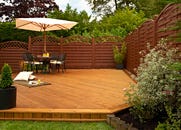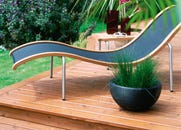Using decking to create a raised area gives you an ideal place for entertaining your friends & family for those long summer evenings. It does not matter if your garden is on a slope or level, timber decking can offer an attractive area for seating.

Tools you will need for to install your garden decking
- Spirit Level - you need to make sure the levels are right.
- Saw - the decking needs to be cut cleanly so a good saw is important.
- Posthole Digger / Spade - key to making a sturdy base.
- String / Ranging Line - key to a straight base.
- Gloves / Goggles - safety always comes first.
How to Lay Wooden Garden Decking
- Decking area: Work out the area you want to cover with decking and mark it out with pegs and a line making sure all the corners are perfectly square. Clear away all debris, vegetation and grass and level the area as best you can.
- Fixing: If your decking is to be connected to the wall of your house you can attach it using a ‘timber wall plate’ secured with masonry bolts at 400mm intervals. Good practise is to make sure the finished level of the deck is at least 2 brick courses below your house’s damp course level. Dig holes 600mm deep for each of the decking frame posts and concrete them in with Post Fix making sure all the posts are perfectly vertical. It is usual practise for posts to be set in at 1.2m intervals to each other throughout the deck, and the posts around the perimeter are offset to one side to allow for the decking frame’s perimeter joists to be secured. Once all the posts are set fast, the marking out lines and pegs can be removed.
- Weed control: It is a good idea to cover the ground with a weed control fabric at this point. It can be held down with shingle and will aid drainage as well as prevent vegetation growing under your new deck.
- Main framework: Making the decking frame is your next job. Fix timber joists to the outer side of each of the corner posts to create a perimeter frame. Next infill the frame with joists at 400mm centres. Remember the joists run in the opposite direction to the decking.
- Balustrading choice: Balustrading will add that touch of class to your decking so before attaching boards you should make this your next job. Firstly work out spacing of newel posts which are usually set at a maximum of 2.4m apart. The corner ones can be slotted in the gap left when constructing the decking frame and secured with coach screws. You can fix intermediate ones using same method with just one coach screws at this point to allow for adjustment when fitting balustrade panels. Cut your base and top rail to size and drill pilot holes through both base rail and top rail fillet to enable balusters to be secured, usually at 100 to 120mm centres. Fix balusters firstly to the top handrail fillet and then to the base rail using 50/75mm galvanised screws. The balustrade panels can be fixed to the posts by means of 12mm timber dowels glued in making sure to leave a 50mm gap under the base rail.
- Boarding the deck: Now fit the Decking boards. Start from the outer edge and work inwards cutting notches to fit around posts on edge boards and allow the decking boards to cover the outer edge of the frame. Make sure your first board is level with edge of the framework and fix it with two 65mm long decking screws, attaching the decking to each of the frame joists below. Remember to leave at least a 5mm gap between each decking board to allow for timber expansion. If your decking boards meet in length, make sure these butt joints are supported by the decking frame below and stagger these joints throughout the deck to maintain a strong structure.
- Safety: If you have a large gap beneath the deck it is a good idea to fix trellis panels or decking to the perimeter to stop pets and children getting trapped under your platform.
- Treatment: It is always a good idea to give your decking a regular coat of a sealing product or stain, this will ensure it always looks its best throughout the year.
- Planning Permission: Usually decking installations which cover no more than 50 percent of the garden or are no more than 30cm above the ground are sanctioned within permitted development allowances. However if you are unsure we suggest you check with your local planning office.





.jpg)